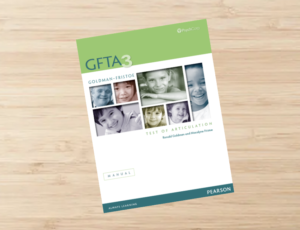Giving the Goldman-Fristoe Test of Articulation 3rd Edition (GFTA-3)
The Goldman-Fristoe Test of Articulation 3rd Edition (GFTA-3) assesses a client’s ability to produce all consonants in General American English in the initial, medial, and final positions of words. Pediatric Speech-Language Pathologists (SLPs) commonly use this standardized measure. Giving the GFTA-3 is a straightforward process and is often the first measure that most SLPs encounter during their graduate school training.

The GFTA-3 is for clients aged 2-21 years. Pictures are presented and the client is asked to label items in the picture that contain the target sounds. There are two sets of pictures- one for younger children and one for older children or clients.
GFTA-3 Areas of Assessment
The examiner presents pictures and asks the client to label items in the picture that contain the target sound/s. They assess all of the consonant sounds, including blends, in all positions of words (initial, medial, final) that they occur.
Scoring the GFTA-3
After giving the GFTA-3, evaluators can obtain a standard score if needed for justifying services. However, all SLPs know that the specific sounds produced in error are what is important vs. a standard score, which doesn’t tell you anything about the client’s performance. SLPs should look at the client’s phonological repertoire and compare with the expected norms, such as the Iowa-Nebraska Norms.
Additionally, after assessing the client’s production of sounds in words, evaluators should do a few more informal observations to get the full picture of the client’s phonological repertoire.
- Stimuability– evaluators should probe the client to see if they can produce target sounds in isolation, syllables, or words following a simple verbal model.
- Connected speech– evaluators should engage the client in a short conversation and listen for additional sound errors that were present at the word level.
- Intelligibility– evaluators should judge the client’s intelligibility in sentences and conversation.
Articulation Norms
The chart below lists all of the consonant sounds in General American English and the age in which they should be developed, according to the Iowa-Nebraska Articulation Norms.

Intelligibility Norms
To determine the impact of articulation errors, a child’s intelligibility level should be considered. Below are the expected intelligibility level by age according to Pena-Brooks, Adriana, & Hedge:
2 years- Unfamiliar listeners should understand 50% of utterances at the sentence level
3 years- Unfamiliar listeners should understand 75% of utterances at the sentence level
4 years- Unfamiliar listeners should understand 75-90% of utterances at the sentence level 7
5+ years- Unfamiliar listeners should understand 90-100% of utterances at the sentence level
For more info on report writing, check out these resources- ⬇️
Blog post: Write a Great Speech and Language Report
FREE course: Write Speech and Language Reports Like a Boss
